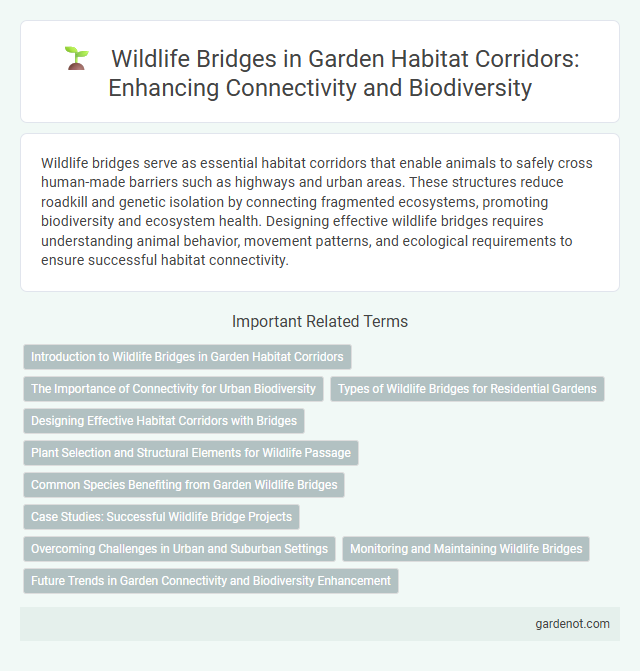Wildlife bridges serve as essential habitat corridors that enable animals to safely cross human-made barriers such as highways and urban areas. These structures reduce roadkill and genetic isolation by connecting fragmented ecosystems, promoting biodiversity and ecosystem health. Designing effective wildlife bridges requires understanding animal behavior, movement patterns, and ecological requirements to ensure successful habitat connectivity.
Introduction to Wildlife Bridges in Garden Habitat Corridors
Wildlife bridges in garden habitat corridors serve as critical structures that facilitate safe animal movement across fragmented landscapes, reducing roadkill and promoting genetic diversity. These green overpasses are designed with native vegetation and natural materials to mimic the surrounding habitat, encouraging species such as deer, foxes, and amphibians to use them. By linking isolated gardens and green spaces, wildlife bridges enhance connectivity, supporting ecosystem health and resilience.
The Importance of Connectivity for Urban Biodiversity
Wildlife bridges enhance habitat corridors by enabling safe passage for diverse species across urban barriers, preserving genetic diversity and preventing population isolation. These structures mitigate the impact of roads and urban development on ecosystems, supporting migration, foraging, and breeding activities. Maintaining connectivity through wildlife bridges is crucial for sustaining resilient urban biodiversity and ecosystem health.
Types of Wildlife Bridges for Residential Gardens
Wildlife bridges for residential gardens include green roofs, vine-covered trellises, and mini canopy walkways designed to facilitate safe animal movement. These structures provide essential habitat connectivity, allowing local species such as birds, squirrels, and insects to navigate urban environments. Integrating native plants and natural materials enhances ecological effectiveness and supports biodiversity in fragmented landscapes.
Designing Effective Habitat Corridors with Bridges
Designing effective habitat corridors with wildlife bridges involves integrating ecological principles to ensure safe animal passage across fragmented landscapes. Key factors include selecting appropriate locations based on species migration patterns, incorporating natural vegetation to mimic native habitats, and using materials that reduce human disturbance and promote animal usage. Monitoring post-construction wildlife movement data helps refine bridge design for enhanced connectivity and biodiversity conservation.
Plant Selection and Structural Elements for Wildlife Passage
Plant selection for wildlife bridges prioritizes native, diverse vegetation that provides food, shelter, and natural camouflage, supporting local fauna during crossings. Structural elements include gentle, wide slopes and permeable surfaces that mimic natural habitats, facilitating safe and stress-free wildlife movement. Incorporating trees, shrubs, and ground cover enhances habitat connectivity and promotes ecological resilience across fragmented landscapes.
Common Species Benefiting from Garden Wildlife Bridges
Garden wildlife bridges significantly enhance habitat connectivity for common species such as squirrels, raccoons, and various songbirds, enabling safe passage over urban barriers. These structures reduce road mortality and promote gene flow by linking fragmented green spaces, benefiting small mammals, amphibians, and pollinators like bees and butterflies. Effective design incorporates native vegetation and natural materials, attracting diverse species and supporting local biodiversity.
Case Studies: Successful Wildlife Bridge Projects
The Banff Wildlife Crossings in Canada exemplify successful habitat corridors by reducing wildlife-vehicle collisions by over 80% since their implementation, protecting species like bears, wolves, and elk. In the Netherlands, the Natuurbrug Zanderij Crailoo serves as a key habitat connector, enabling safe passage for red deer and amphibians across highways. Spain's AP-7 Eco-bridge showcases effective integration of habitat corridors, increasing species movement and genetic diversity, particularly for Iberian lynx and other endangered fauna.
Overcoming Challenges in Urban and Suburban Settings
Wildlife bridges effectively overcome barriers created by urban and suburban development by providing safe passage for animals across highways and roads, reducing vehicle collisions and habitat fragmentation. These structures incorporate ecological design elements such as native vegetation and noise barriers to mimic natural environments, encouraging animal movement and preserving biodiversity. Successful implementation requires collaboration between urban planners, ecologists, and engineers to address site-specific challenges including limited space, heavy traffic, and human activity.
Monitoring and Maintaining Wildlife Bridges
Monitoring and maintaining wildlife bridges involves using remote cameras, GPS tracking, and environmental sensors to collect data on animal crossings and habitat use. Regular inspections ensure structural integrity and remove debris or vegetation that may hinder wildlife movement. Adaptive management based on monitoring results optimizes bridge effectiveness, promoting safe passage and biodiversity conservation.
Future Trends in Garden Connectivity and Biodiversity Enhancement
Wildlife bridges are poised to become integral components of garden connectivity, facilitating gene flow and species movement across fragmented urban landscapes. Emerging trends emphasize the integration of native vegetation and smart monitoring systems to enhance biodiversity and ecosystem resilience. Such corridors not only reconnect isolated habitats but also support pollinator networks and improve overall environmental health within garden ecosystems.
Wildlife bridge Infographic

 gardenot.com
gardenot.com